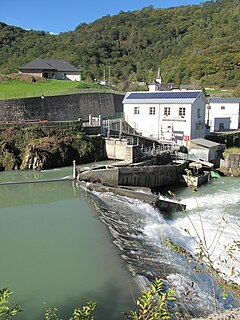
Small hydro is the development of hydroelectric power on a scale suitable for local community and industry, or to contribute to distributed generation in a regional electricity grid. Precise definitions vary, but a "small hydro" project is less than 50 megawatts (MW), and can be further subdivide by scale into "mini" (<1MW), "micro" (<100 kW), "pico" (<10 kW). In contrast many hydroelectric projects are of enormous size, such as the generating plant at the Three Gorges Dam at 22,500 megawatts or the vast multiple projects of the Tennessee Valley Authority.

Hydroelectricity, or hydroelectric power, is electricity produced from hydropower. In 2015, hydropower generated 16.6% of the world's total electricity and 70% of all renewable electricity, and was expected to increase by about 3.1% each year for the next 25 years.

Hugh Keenleyside Dam is a flood control dam spanning the Columbia River, 12 km upstream of the city of Castlegar, British Columbia, Canada.

The Manitoba Hydro-Electric Board, operating as Manitoba Hydro, is the electric power and natural gas utility in the province of Manitoba, Canada. Founded in 1961, it is a provincial Crown Corporation, governed by the Manitoba Hydro-Electric Board and the Manitoba Hydro Act. Today the company operates 15 interconnected generating stations. It has more than 527,000 electric power customers and more than 263,000 natural gas customers. Since most of the electrical energy is provided by hydroelectric power, the utility has low electricity rates. Stations in Northern Manitoba are connected by a HVDC system, the Nelson River Bipole, to customers in the south. The internal staff are members of the Canadian Union of Public Employees Local 998 while the outside workers are members of the International Brotherhood of Electrical Workers Local 2034.
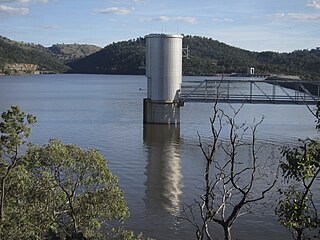
Wyangala Dam is a major gated rock fill with clay core embankment and gravity dam with eight radial gates and a concrete chute spillway across the Lachlan River, located in the south-western slopes region of New South Wales, Australia. The dam's purpose includes flood mitigation, hydro-power, irrigation, water supply and conservation. The impounded reservoir is called Lake Wyangala.

TransAlta Corporation is an electricity power generator and wholesale marketing company headquartered in Calgary, Alberta, Canada. It is a privately owned corporation and its shares are traded publicly. It operates 75 power plants in Canada, the United States, and Australia. TransAlta operates wind, hydro, natural gas, and coal power generation facilities. The company has been recognized for its leadership in sustainability by the Dow Jones Sustainability North America Index, the FTSE4Good Index, and the Jantzi Social Index. TransAlta is Canada's largest investor-owned renewable energy provider. The company is not without controversy as the Alberta Utility Commission ruled in 2015 that TransAlta manipulated the price of electricity when it took outages at its Alberta coal-fired generating units in late 2010 and early 2011.

The Lipno Reservoir is a dam and hydroelectric plant constructed along the Vltava River in the Czech Republic. It is the largest water area in the Czech Republic.

Run-of-river hydroelectricity (ROR) or run-of-the-river hydroelectricity is a type of hydroelectric generation plant whereby little or no water storage is provided. Run-of-the-river power plants may have no water storage at all or a limited amount of storage, in which case the storage reservoir is referred to as pondage. A plant without pondage is subject to seasonal river flows, thus the plant will operate as an intermittent energy source. Conventional hydro uses reservoirs, which regulate water for flood control, dispatchable electrical power, and the provision of fresh water for agriculture.
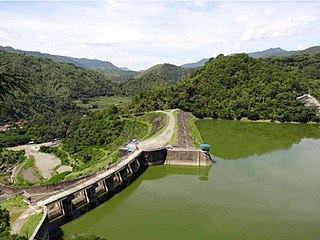
Binga Dam is a dam in Agno River connected to a hydroelectric power plant situated at Barrio Binga, Barangay Tinongdan in the municipality of Itogon in Benguet province of the Philippines.

The Silin Dam is a concrete gravity dam on the Wu River in Sinan County, Guizhou Province, China. The dam has an associated hydroelectric power plant with a 1,080 MW capacity utilizing 4 x 270 MW Francis turbine-generators. The dam is 310 m (1,017 ft) long, 117 m (384 ft) high and composed of roller-compacted concrete. Its reservoir has a 1,205,000,000 m3 (976,909 acre⋅ft) capacity, 184,000,000 m3 (149,171 acre⋅ft) of which is flood storage. The dam also supports ship lift. Construction on the dam began in October 2004, the dam began to impound the river in March 2008 and by May 2009, the power plant's first generator was operational. The remaining generators were operational by December 2009.

The Koteshwar Dam is a gravity dam on the Bhagirathi River, located 22 km (14 mi) downstream of the Tehri Dam in Tehri District, Uttarakhand, India. The dam is part of the Tehri Hydropower Complex and serves to regulate the Tehri Dam's tailrace for irrigation and create the lower reservoir of the Tehri Pumped Storage Power Station. In addition, the dam has a 400 MW run-of-the-river power station. The project was approved in 2000 and its first generator was commissioned on 27 March 2011, the second on 30 March 2011. The construction site had been inundated in September 2010 by floods. The diversion tunnel was later blocked heaving/collapse of the hill in December 2010. The spillway was commissioned in Jan, 2011. The last two generators were made operational in March 2012.
![Cirata Dam Dam in Plered, Purwakarta [id]](https://upload.wikimedia.org/wikipedia/commons/thumb/9/94/Indonesia_relief_location_map.jpg/320px-Indonesia_relief_location_map.jpg)
The Cirata Dam is an embankment dam on the Citarum River in West Java, Indonesia. It is located 100 km (62 mi) southeast of Jakarta. It was constructed between 1984 and 1988 for the primary purpose of hydroelectric power generation. Other purposes include flood control, aquaculture, water supply and irrigation. The 125 m (410 ft) tall concrete-face rock-fill dam is situated just before a sharp bend in the river and withholds a reservoir with a gross storage capacity of 2,165,000,000 m3 (1,755,194 acre⋅ft). The reservoir has a surface area of 62 km2 (24 sq mi) which caused the relocation of 6,335 families. The dam's power station is located on the north side of the river bend and contains eight 126 MW Francis turbine-generators. It has a total installed capacity of 1,008 MW and an annual generation of 1,426 GWh. The power station was completed in two phases, the second was completed in 1998. It serves mostly as a peaking power plant and is the largest hydroelectric power station in Indonesia. The construction of the dam resulted in involuntary resettlement of 56000 people.

The Jatigede Dam is an embankment dam on the Cimanuk River in Sumedang Regency, West Java, Indonesia. It is located 19 km (12 mi) east of the town of Sumedang. Construction on the dam began in 2008 and it was completed in 2015. The power station is expected to be commissioned in 2019. The primary purpose of the dam is irrigation but it will also provide for flood control, water supply and hydroelectric power generation. Water in the reservoir will be used to help irrigate 90,000 ha of farmland and the power station is expected to have a 110 MW capacity. The project has become controversial, primarily due to the relocation of people in the future reservoir zone.

The Daryan Dam, also spelled Darian, is an embankment dam constructed on the Sirvan River just north of Daryan in Paveh County, Kermanshah Province, Iran. The primary purpose of the dam is to supply up to 1,378,000,000 m3 (1,117,000 acre⋅ft) of water annually to the 48 km (30 mi) long Nosoud Water Conveyance Tunnel where it will irrigate areas of Southwestern Iran. The dam also has a 210 MW hydroelectric power station. Construction on the dam began in 2009 and the dam began to fill its reservoir in late November 2015. The Darian Dam Archaeological Salvage Program (DDASP) was planned by Iranian Center for Archaeological Research before flooding the reservoir. As a result a number of important archaeological sites were discovered and some were excavated. The power station was commissioned in 2018. The dam's diversion tunnel was completed in June 2011. The dam was designed by Stucky of France and consultation was provided by Mahab Ghodss, International Consulting Engineering Co. In August 2010 Farab Co. won the contract to build the power station. In 2011, workers on the project held a protest against unpaid wages. The dam is also the subject of protest due to the forced relocations and ecological/cultural impact its reservoir will have.

Allai Khwar Hydropower Plant is a run-of-the-river, high head project of 687 metres, located in the Battagram District on the Allai Khwar River, a left bank tributary of Indus River in Khyber Pakhtunkhwa Province, Pakistan. It is approximately 245 km from the federal capital of Islamabad and 330 km from the provincial capital of Peshawar, in the Islamic Republic of Pakistan.

The Tapovan Vishnugad Hydropower Plant is a 520 MW run-of-river hydroelectric project being constructed on Dhauliganga River in Chamoli District of Uttarakhand, India. The plant is expected to generate over 2.5 TWh of electricity annually.
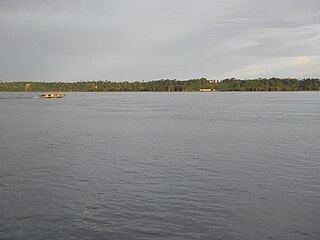
The Jatobá Hydroelectric Power Plant is a planned hydroelectric power plant and dam on the Tapajós river in the state of Pará, Brazil. As of 2017 the project was suspended.
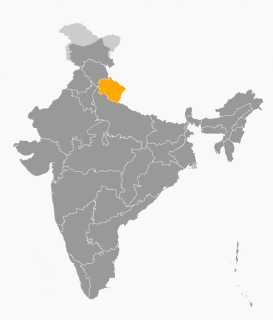
The 2021 Uttarakhand flood, also known as the Chamoli disaster, began on 7 February 2021 in the environs of the Nanda Devi National Park, a UNESCO World Heritage Site in the outer Garhwal Himalayas in Uttarakhand state, India. It was caused by a large rock and ice avalanche consisting of material dislodged from Ronti peak. It caused flooding in the Chamoli district, most notably in the Rishiganga river, the Dhauliganga river, and in turn the Alaknanda—the major headstream of the Ganges. The disaster left over 200 killed or missing, most were workers at the Tapovan dam site.

The Vishnuprayag Dam lies in Chamoli district at the conjunction of Alaknanda River and Dhauliganga River, in the Indian state of Uttarakhand, India.













![Cirata Dam Dam in Plered, Purwakarta [id]](https://upload.wikimedia.org/wikipedia/commons/thumb/9/94/Indonesia_relief_location_map.jpg/320px-Indonesia_relief_location_map.jpg)





